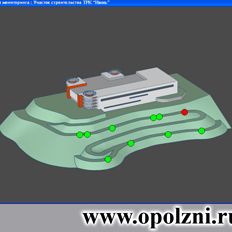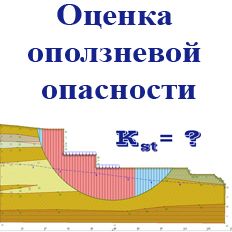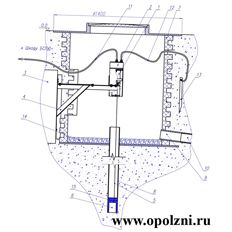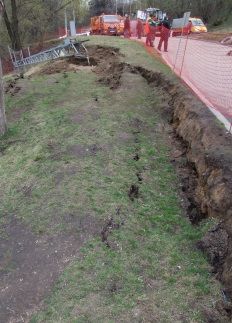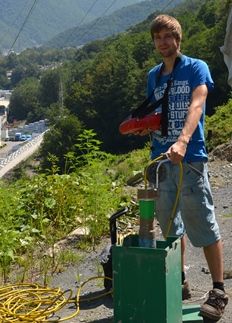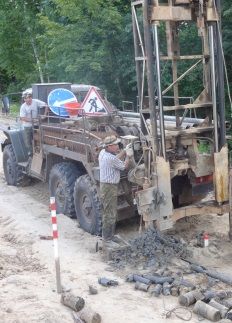Институт геоэкологии им. Е.М. Сергеева РАН
About protection strategy on territories with deep landslides.
A.I. Kazeev, G.P. Postoev. // Environmental Geosciences and engineering survey for territory protection and population safety: abstracts to proceeding, EngeoPro-2011. –Moscow: I.E. Kiseleva N.V., 2011. -P. 108-109. Читать…
!!! При КОПИРОВАНИИ материалов статей — НЕОБХОДИМО ИСПОЛЬЗОВАТЬ библиографические ССЫЛКИ на Статьи !!!
Abstract: Deep block-type landslides are widespread on plain territories. The article contains scientific explanation of effective reinforcement of the considered landslide type. The suggested protection strategy bases on theoretical solutions of destructive phase forming (prepare) of landslide deformations, on taking into account mechanism peculiarities of deep block-type landslide development, and also on investigation experience of such landslides in different engineering-geological conditions.
Deep block-type landslides are widespread. Particularly big troubles concerning deep landslides forming appear on urban territories.
From one side, slow development of deformations on landslide areas provides illusion of relative stability of the considered territory with possibility of its economic use, especially in conditions of high dense city building. From other side, periodic destructive landslide process activization, affecting significant territories, provide sometimes unsolvable tasks in protection of economical objects and native landscape preservation.
The reinforcement of slopes on territories with deep block-type landslides meets certain difficulties concerning the complexity of forming mechanism and activization of a landslide, large sizes of landslide circuses, the depth of the slip surface and necessity of strain and stress state evaluation of a landslide massif, consisting of moved landslide blocks, and of a native massif situated above it [4].
More than 700 cities in Russia are liable to landslides (including deep slides), among them: Moscow, Nizhniy Novgorod, Kazan, Ulyanovsk, Volgograd, Cheboksary, Saratov, Saransk, Perm, Sochi, Rostov-on-Don, Tomsk, and Barnaul.
Superficial relatively shallow landslides (with depth of soil capture 2 – 5 m, and rarely to 10 m), with which inevitably it is necessary to face while building on slope territories, usually is possible to make stable by certain complex of measurements, including regulation of superficial and underground waters, drainage of landslide masses, increase of strength and density of deforming rocks in displacement zone of a landslide and by keeping constructions in the form of retaining walls, raft foundations, counter banquets and counter forces.
A more difficult task is protection against large deep landslides. Russian experience of landslide prone territories urbanization shows that we can’t reach total stabilization of slope with deep landslides. The most usual measurements used for this purpose, are: shore reinforcement, drainage, making terraces on a slope, building counter banquets and more rare – pileworks.
However activization of deformations and catastrophic movements of deep landslides periodically occur also on the strengthened slopes, providing a considerable damage to an existing infrastructure. For example, in Saratov on a slope of Sokolovoj Mountain landslides, with deformation of lower Cretaceous clays (depth of slip surface more than 100 m), occurred in 1783, 1818, 1846, 1869, 1884, 1913, 1915, 1927, 1967, 1968, 1986, with destructive deformations of a city territory and with lifting of the river Volga bottom. The volume of displacing masses is about 10 million м3 [6].
Effective protective measurements and rational development of slope territories where the development of deep landslide movements is possible should be based on taking into account the peculiarities of the mechanism of block-type landslides forming and development. These aspects are considered in given article.
The mechanism peculiarities of a deep landslide development. At a formation stage of a sliding block in a native soil massif takes place a compression (crush) of bottom horizons, forming in soils, structural strength of which is smaller than pressure of the upper-lying layers, side horizontal pressure (thrust). Against this active thrust pressure is counteracting passive horizontal pressure in deformed horizon from the slope side. Thus the above lying layers of slope deposits provide passive load on deforming horizon. When the meaning of vertical passive load become insufficient to counterbalance mentioned active horizontal pressure, near-edge part of a native massif, adjoining to a slope at the top, settles and separates from other part of a native massif forming a steep crack. The new block is displacing along an steep curvilinear slip surface which changes to nearly horizontal to the bottom (inside the main deforming horizon), pushing and moving the existing landslide body, consisted of earlier displaced blocks, along almost horizontal slip surface. Except lateral moving sliding blocks can make turns on a rotational trajectory, quite often increasing the degree of block’s falling back, while moving away from the edge of a slope.
The reason of natural deep block-type landslides forming, as rule, is undermining of high slopes by river (sea) waters. However the subsequent activization of deep motions can occur also in the absence of active processing of the bottom part of a slope. The development of the sliding process in a formed landslide circus occurs with different rate of activity in time until the blocks which have separated from a native massif, settling, continue to push and move slope sliding masses towards the river. The process reaches temporary stabilization when landslide slope becomes gentle, and a rather flat landslide terrace, adjoining a high failure wall (a slope besides blocks), is formed. Critical value of a failure wall height is evidence of a limited state of stability achievement of near edge parts of a native massif and the possibility of stability loss at any moment.
The specialty of the mechanism of deep block-type landslides activization is so-called property of «self-development». This means the following. Separated from a native soil massif sliding block while settling moves situated in front of it landslide masses, forming along the border with a native soil massif at side borders of the block the lowered tension cracks, which make deep cut of a native massif. In this time passive horizontal side pressure decreases from the slope side in deforming horizon of a massif and a new landslide block forms in a native massif.
1. Regulating consequences of the landslide process mechanism.
«The chain of cause and effect relationships of specialty of the landslide deformations mechanism – protective measures» is illustrated on fig. 1.
The activity of landslide displacements in a circus is provided by high position of landslide block, adjoining the upper border (failure wall) of a landslide slope (fig. 1.1). Displacement of landslide body, as it was showed above, is caused by settling of the mentioned block and its power influence on other part of sliding massif in the circus. The intensity of displacements depends as from sliding blocks sizes, soils in which sliding process develops, and rate of factors influence. In strong rock massifs, on high slopes this process can proceed through many centuries. This is an important regularity of deep displacements. It is necessary for considering in cases of building on landslide prone territories and adjoining water area of reservoirs and when from external indications it is considered that there are no deformations on a slope.
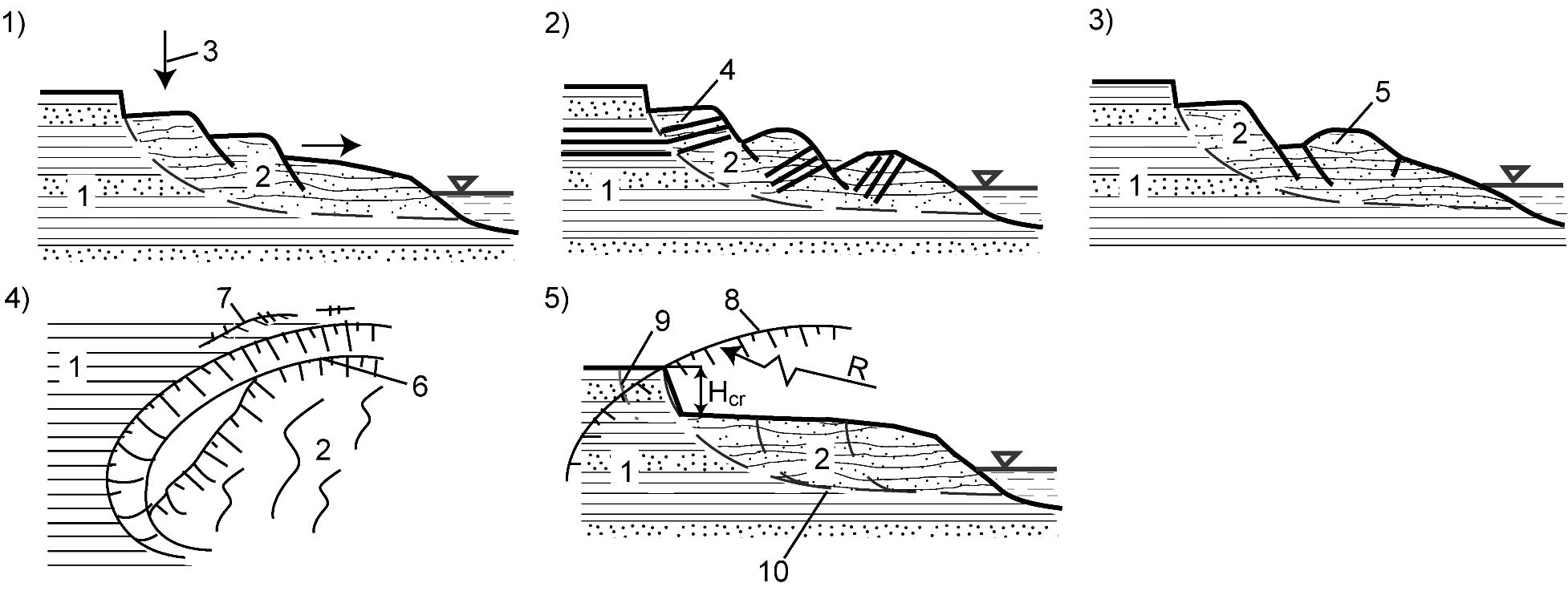
Fig. 1. Characteristic schemes of a landslide slope with deep block-type landslide (2) development, (1) – a native massif. 1) High position of the upper sliding block, regulating the displacement (3). 2) Translation and rotary movements of blocks (4 – a marking rigid layer). 3) A bulge of compression (5) in a landslide body; 4) Formation of a «cutting» failure (6) at the bottom of a failure wall and «main» (rear) failure (7) in landslide native massif; 5) The limited state of a native massif near a failure wall with edge (8) radius R and preparation of a new landslide block (9); 10 – a slip surface.
2. Translation and rotary movements of landslide blocks is a specific property of landslides of considered type. It is significantly caused by the mechanism of landslide blocks formation in the form of compression (crush) of deforming horizon soils, their extrusion towards the slope with settling and rotating of the block (fig. 1.2). On the basis of researching of landslides at Odessa coast of Black sea P.N. Naumenko showed that the rotary motion of blocks, while their displacement down the slope, occurs by the trajectories which are close enough to circular [3]. I.e. the angle of rotation of a marking rigid layer (in Odessa it is presented by a limestone layer of Pontik stage of Pliocene 6-13 m thickness) increased in process of translation moving of landslide massif. Thus under blocks in a deforming soil appear specific bulges of extrusion (fig. 1.2).
As a consequence of the given regularity of landslide process development is a necessity of the account of diverse movements of blocks at building of constructions on any landslide prone slope area. In case of considerable thickness of landslide massif the prevention of deformations of constructions and maintenance of its safe functioning become a big problem.
3. Formation of a «compression bulge». This element of relief can be met in landside centres, in which landslide massif is presented by a significant amount of sliding blocks, creating a natural counterbanquet to the new block, separated from a native massif (fig. 1.3). In this case in any part a landslide slope caused by pressure of the new block is forming a bulge– «median landslide compression bulge» [1]. Below a «bulge» on a slope landslide deformations are insignificant.
The given position regulates requirements for using and placing of keeping constructions. In the top part of a landslide slope the activity of landslide process development can remain. Moreover, as it would be shown below, catastrophic activization of landslide deformations is possible.
4. The effect of self-development is a specific property of deep block-type landslides. The effect presents that each new block in process of its` settling forms on block «wings» the lowered crack of tension resulting from moving by the block from a failure wall of all landslide massif (fig. 1.4). Thus the mentioned landslide crack (6) «cuts» a landslide prone massif (1), forming «main» cracks on its top platform, giving evidence of the beginning of process of its stability decrease and preparation of a new landslide block.
Such events are frequent on frontal extended (along coast) landslide circuses, what is characteristic mainly for sea coasts. In Odessa in a same landslide amphitheatre in 1964 there was a catastrophic activization with a new block 420 m in length (along coast) forming. And in 1965, according to effect of «self-development», to the south from a place of activization of 1964 a new block 270 m in length was formed, resulted in also catastrophic activization of landslide masses displacement in amphitheatre (centre) [3].
Sometimes consider that mainly side erosion (abrasion) defines intensity of development of deep landslide movements. But the effect of «self-development» testifies that once having begun the process of landslide blocks forming and development of landslide deformations in the formed circus, it can proceed and without influence of external influencing factors, including the processing of the bottom part of a slope, i.e. removal of a natural counter banquet.
The knowledge of the specified feature of the mechanism is necessary at designing of mitigation (protection) measures.
5. The mechanism of catastrophic activization of a landslide process. As it was mentioned above, the development of a sliding process in form of deep block-type movements subside, when a flat landslide terrace is formed (fig. 1.5) – the end of a landslide cycle.
In this moment on a circus (centre) axis the height of a failure wall reaches critical value Hcr. At this time deformations on a landslide slope temporarily are absent, the landslide body (2) is motionless, but the native massif (1) is in a limited state which for the given landslide circus can be defined through the equation [5]:
 ,
,
where σ1а and σ1р – values of vertical gravitational pressure on horizon with a slip surface, accordingly, in a native massif (active zone) and in a sliding massif (passive zone); σstr – soil structural strength in native lying on the mentioned horizon; R – an edge curve radius of considered landslide circus.
The transition from temporarily stable limited state to catastrophic activization of a landslide process, with formation of a new sliding block and with destructive deformations, covering all landslide circus, can occur as in the form of evolutionary change of the strain and stress state in a landslide prone native massif, or suddenly, resulting from abnormal influence of any factor. The latter serves as «trigger » of landslide deformations activization [2].
Thus, the major tasks of protective measurements on territories with development of deep block-type landslides are: timely revealing of landslide prone sites on native massif, which condition comes nearer to limited; site definition in a cross-section of a massif of a slip surface, the lateral movement of blocks and working out of effective methods to increasing the stability of the revealed sites with a limited state for prevention of new landslide blocks formation and the development of destructive deformations.
Based on the analysis of the mechanism of landslide deformations development in considered circus and on theoretical solutions [5] the program PK-slide for revealing of a slip surface (10) was developed by the authors – see fig. 1.5. For a landslide site, presented on fig. 2, calculated (using the program) value of a slip surface depth relatively the edge of a landslide prone massif is 31.3m. By data of inclinometric measurements – 31.0m. I.e. we receive almost full coincidence of results.

Fig. 2. A schematic engineering-geological cross-section of a slope in the central part of a site of landslide process activization (Moscow, Horoshevo-1): 1 – a zone of block settlement and formation of a bulge-compression zone in a head part of a landslide; 2 – a zone of lateral horizontal displacement; 3 – a bulge-compression zone in landslide tongue; 4 – a slip surface; 5 – a landslide body; 6 – Quaternary sand deposits; 7 and 8 – accordingly Tithonian and Oxfordian clays; 9 – a swell of deformed soil extrusion under the block.
Authors offer a new method of strengthening of a landslide massif (the patent of the Russian Federation №2340729), allowing, by formation in a massif of excavation with calculated sizes to raise stability of a landslide prone massif to required level. Also are available other suggestions, directed on decision of a problem of stable state maintenance of a landslide prone massif and a non-admission of catastrophic activization.
Conclusion
The mechanism of deep block-type landslides forming and peculiarities of deformations development in corresponding landslide circuses substantially predetermines development strategy of a slope and realization of protective measurements.
The main positions of the strategy the following:
- Traditional ways of landslide slope strengthening (keeping constructions, drainage actions, cementation etc.), as rule, are ineffective, as sliding blocks have considerable thickness and have big potential energy. Also it is necessary to consider peculiarities of the mechanism (rotary and lateral movement of blocks, a compression bulge, effect of self-development etc.), and often big sizes of frontal landslide circuses, that in a whole creates an insuperable problem. On the assumption of this, reasonably, especially when slow development of deformations of a landslide massif, in economic use of considered territory and designs of constructions to consider possibility of deformations. In this connection to provide monitoring of constructions condition and their preventive repair. Quite often also it is reasonable to direct against-landslides protective actions not on stabilization of whole landslide massif in circus, but on protection and maintenance of normal functioning of constructions located on it.
- The main goal of protective measurements on site of deep block-type landslides development of the compression-extrusion mechanism is revealing of massifs which are in a limited state, and the prevention of catastrophic activization of a landslide process. On the basis of the equation, offered by authors, defining a limited equilibrium of interaction forces of native landslide prone slope and displaced blocks, adjoining it. Ways to increase the stability of native landslide prone massif for the purpose of elimination of threat of a new landslide block formation and destructive deformations development are developed.
The work was made with financial support of RFBR (grant 090500201-a).
References
1. Gulakjan K.A., Kunttsel V.V., Postoev G.P, Erysh I.F. 1973. The mechanism of deep landslides, connected with ancient Neogene residual soil deposits of Kerch peninsula. // Problems and methods of Engineering-geological researches. M: VSEGINGEO. 1973, №. 76, p. 16-28.
2. Kazeev A.I. 2010. The reasons and the mechanism of catastrophic activization of deep block-type landslides in Moscow. // City agglomerations on landslide territories. Materials of 5 international conf.. on geotechnics 22-24.09.2010. Volgograd. VolgSABU. 2010. p.57-64.
3. Naumenko P.N. 1977. Conditions of formation and engineering-geological characteristic of landslides of the Black Sea coast of Odessa. // Landslides of the Black Sea coast of Ukraine. M.:Nedra. Chapter 5. p.57-100.
4. Postoev G.P. 2001. Deep block-type landslides on urban territories. // International symposium «Engineering-geological problems on urban territories» Russia, Ekaterinburg, 2001. p. 335-342.
5. Postoev G.P. 2010. Equations of massif state for landslides formation // Engineering geology. №4, p. 48-53.
6. Tihvinskij I.O. 1988. The assessment and the stability forecast of landslide slopes. Moscow: Science. 144 p.
